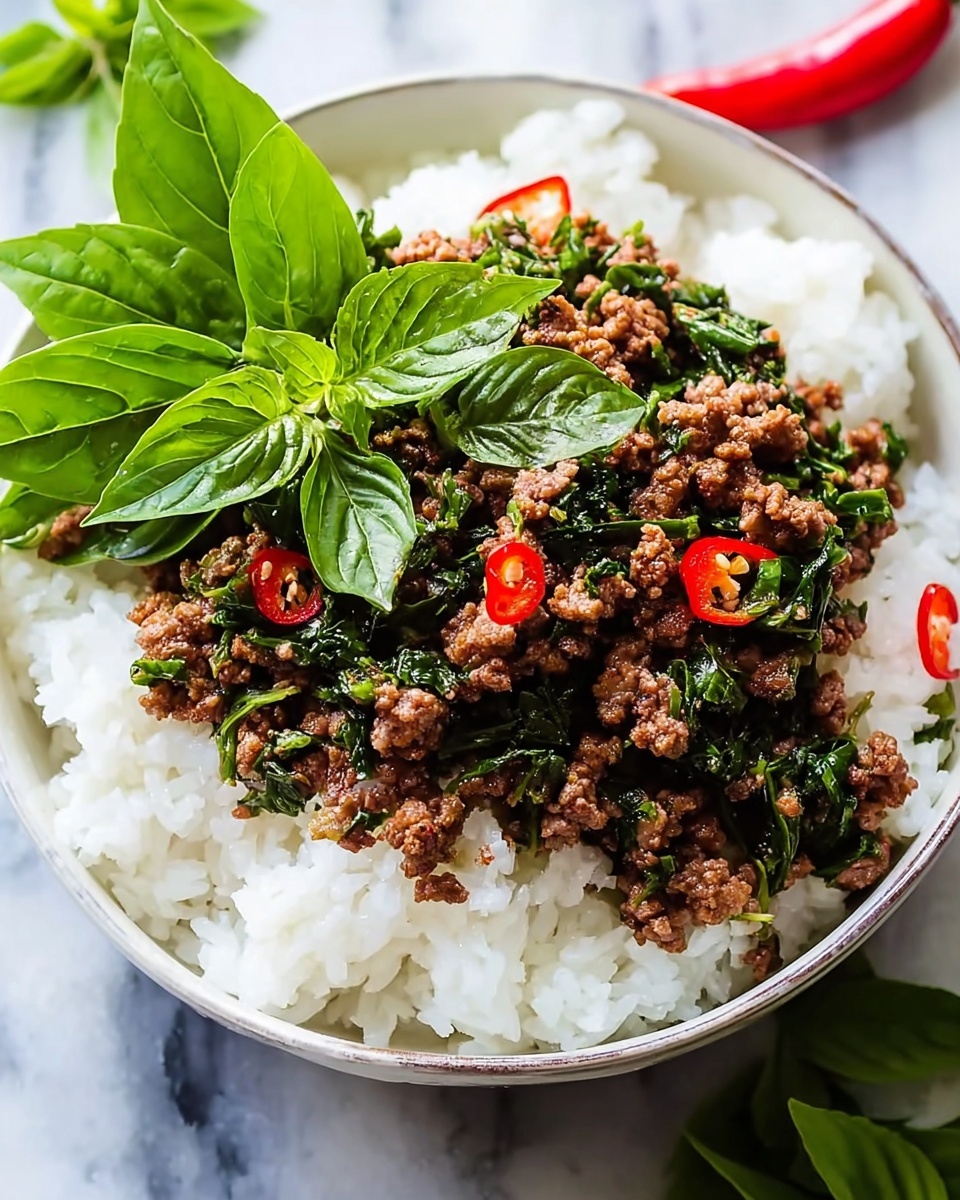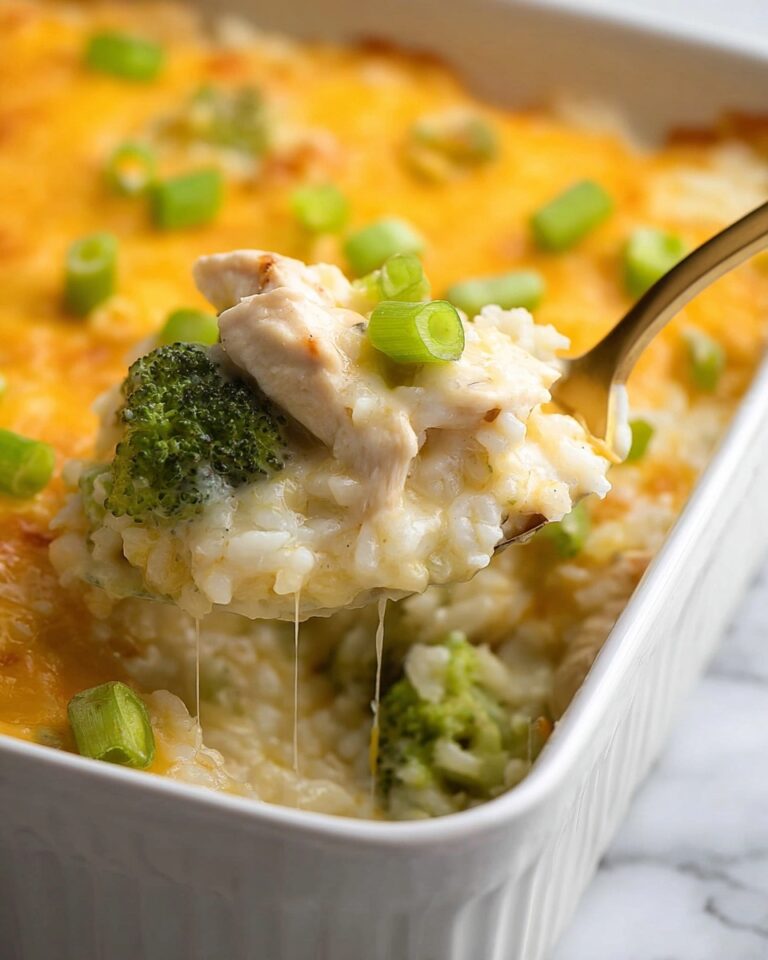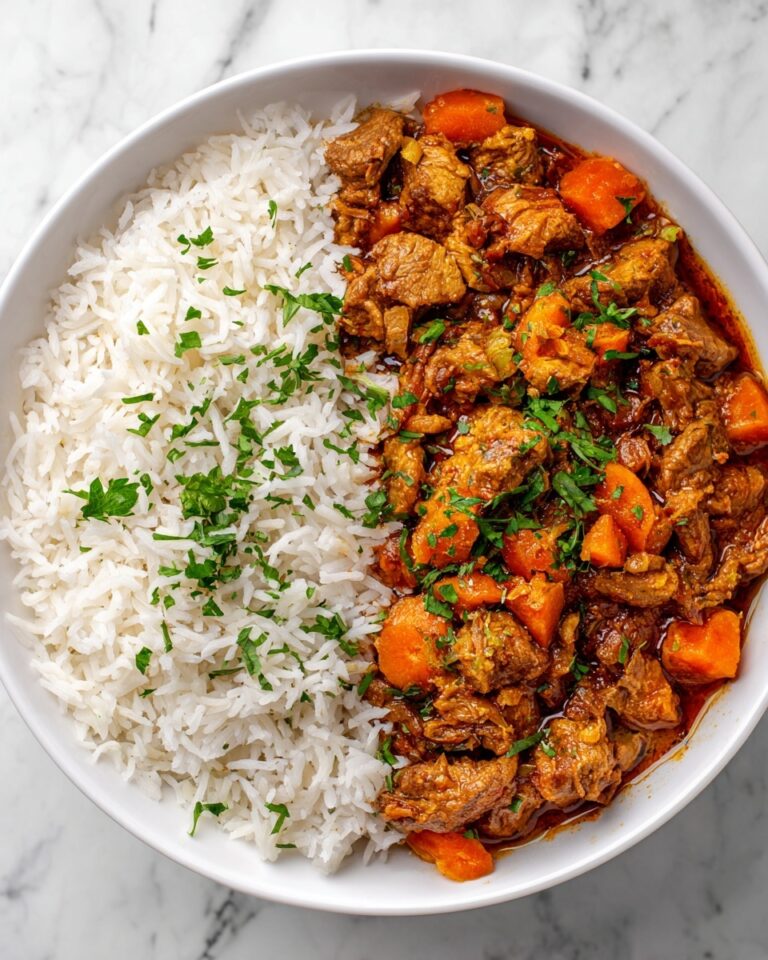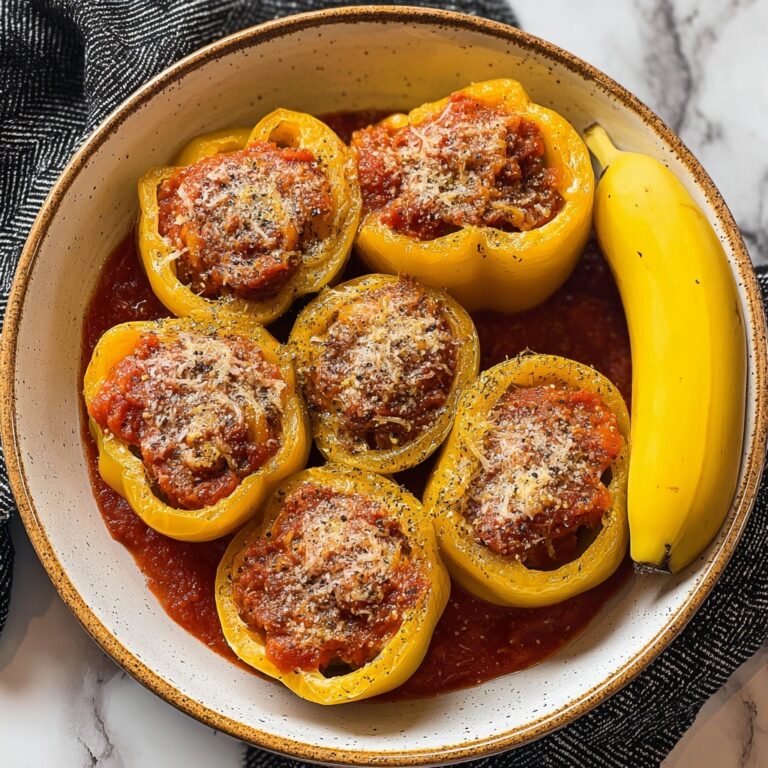If you’ve ever craved something bursting with bold flavors, fresh herbs, and a touch of spice, then this Thai Basil Chicken Recipe is exactly what you need. It’s a vibrant, satisfying dish that combines tender ground chicken with fragrant Thai basil, garlic, and chilies, creating a flavor profile that’s addictively delicious. Whether you’re new to Thai cooking or looking for a quick weeknight favorite, this recipe delivers a perfect balance of savory, sweet, and spicy all in one sizzling pan.
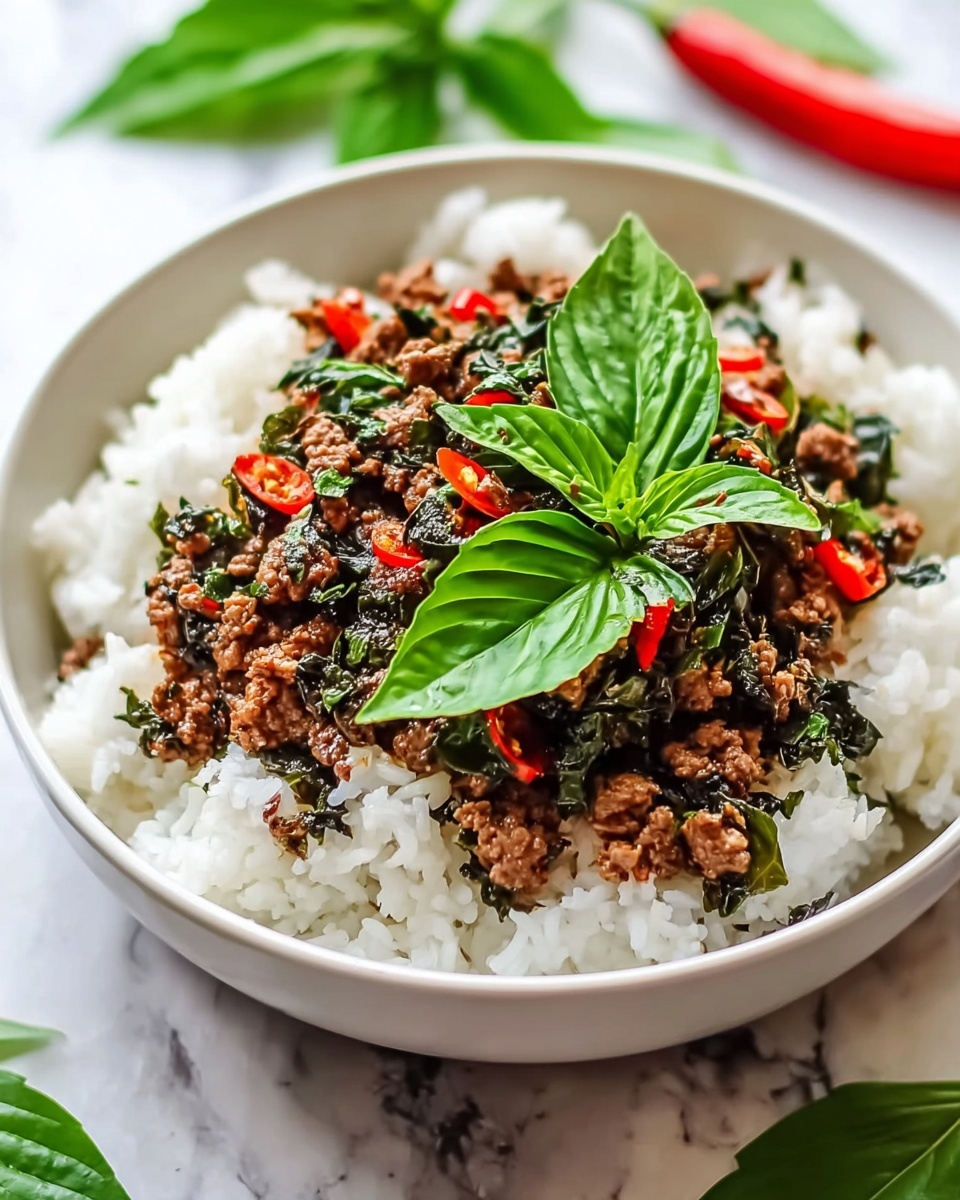
Ingredients You’ll Need
These ingredients are straightforward but absolutely essential to achieving the authentic taste and wonderful texture of this dish. Each one plays a special role in building layers of flavor and bringing a colorful, aromatic presence to the table.
- 3 to 4 tablespoons oil: Helps to sauté the ingredients perfectly and gives the dish a lovely sheen.
- 3 Thai bird chilies or holland chilies: Adds the perfect kick; remove seeds if you want it milder.
- 3 shallots: Thinly sliced for a delicate sweetness and light crunch.
- 5 cloves garlic: Sliced to infuse that unmistakable pungent aroma and rich flavor.
- 1 pound ground chicken: The star protein that absorbs all the savory sauce beautifully.
- 2 teaspoons sugar (or honey): Balances heat and salt with a touch of natural sweetness.
- 2 tablespoons soy sauce: Adds depth and umami to each bite.
- 1 tablespoon fish sauce: Brings authentic salty tang and complexity.
- 1/3 cup low sodium chicken broth (or water): Used to deglaze and keep the chicken tender and juicy.
- 1 bunch holy or Thai basil leaves: The essential herb that gives the dish its bright, refreshing finish.
How to Make Thai Basil Chicken Recipe
Step 1: Heat the Oil
Start by warming the oil in your wok or pan over high heat until it shimmers. This hot oil provides the perfect base for quickly sautéing the aromatics and developing those unforgettable smoky flavors.
Step 2: Sauté Aromatics
Add the sliced chilies, shallots, and garlic to the hot oil. Cook them for a minute or two until fragrant and just tender. This step is where your kitchen starts to smell incredible and the seasoning foundation is built.
Step 3: Add Chicken
Next, toss in the ground chicken. Stir-fry it, breaking it apart, so it cooks evenly and absorbs all the infused flavors. Cooking for about two minutes until the chicken is partially cooked ensures it stays tender.
Step 4: Season the Dish
Now, stir in the sugar, soy sauce, and fish sauce. These three ingredients transform the dish, balancing salty, sweet, and umami tones. Give it a minute to let all those flavors mingle with the chicken.
Step 5: Deglaze the Pan
Pour in the chicken broth or water to deglaze. This step loosens any browned bits stuck in the pan, enhancing the sauce’s richness. Cook over high heat until most of the liquid evaporates, leaving a perfectly glazed chicken stir-fry.
Step 6: Add Basil
Finally, remove the wok from heat and immediately stir in the Thai basil leaves. The residual heat wilts the basil, releasing its fragrant aroma that defines the character of the Thai Basil Chicken Recipe.
How to Serve Thai Basil Chicken Recipe
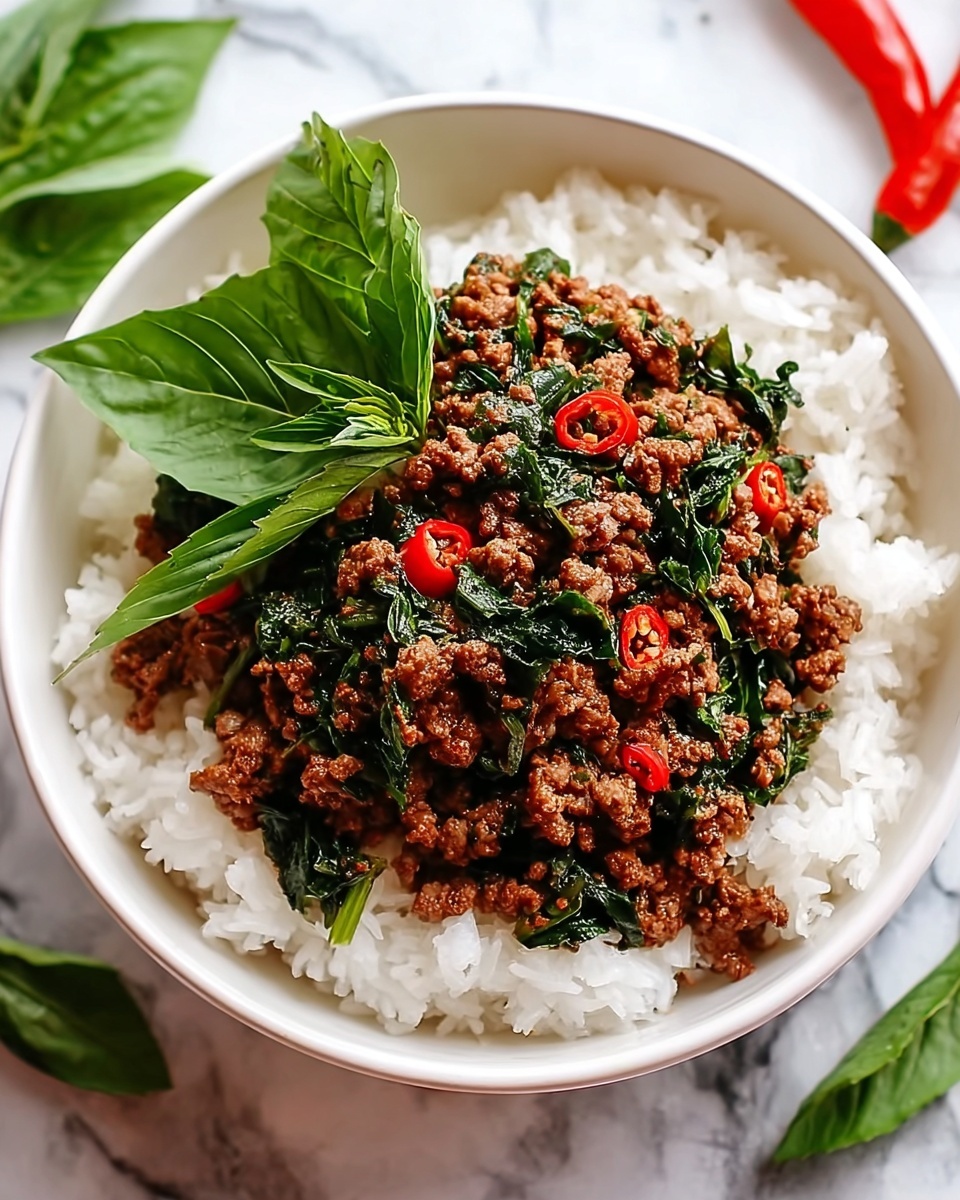
Garnishes
Sprinkle some extra fresh basil leaves or chopped green onions on top just before serving for a pop of color and freshness. A wedge of lime on the side can add a zingy brightness that lifts the dish even more.
Side Dishes
This Thai Basil Chicken Recipe pairs beautifully with simple steamed jasmine rice, which soaks up the delicious savory juices perfectly. You can also serve it alongside lightly blanched vegetables or a crisp cucumber salad to add contrast and a refreshing crunch.
Creative Ways to Present
For a fun twist, serve the Thai Basil Chicken in lettuce cups for a fresh, handheld bite that’s perfect for casual gatherings. Alternatively, pile it over warm rice noodles for a fusion-style bowl that blends textures and flavors excitingly.
Make Ahead and Storage
Storing Leftovers
Place any leftover Thai Basil Chicken in an airtight container and refrigerate. It will stay fresh for up to three days, making it easy to enjoy flavorful meals without extra effort.
Freezing
This dish freezes well for up to two months. Just cool completely, pack it in a freezer-safe container, and thaw overnight in the fridge before reheating.
Reheating
Reheat gently on the stove or in the microwave until warmed through. Add a splash of water or broth if the chicken seems dry to bring back its moist texture and vibrant flavor.
FAQs
Can I use another type of meat in this Thai Basil Chicken Recipe?
Absolutely! Ground pork or turkey work well as alternatives, and sliced chicken breast can be used if you prefer a different texture. Just adjust cooking times accordingly.
What if I don’t have Thai basil?
While Thai basil has a uniquely sweet and licorice-like flavor, if you can’t find it, sweet basil is a decent substitute though the dish won’t be quite the same. For the best flavor, try to seek out Thai basil at Asian markets.
How spicy is this dish?
The heat level depends on how many chilies you use and whether you keep the seeds. You can easily adjust it to your preference by adding more or fewer chilies or seeding them before cooking.
Is this recipe gluten-free?
It can be if you use gluten-free soy sauce or tamari instead of regular soy sauce, and ensure your fish sauce does not contain gluten additives. Always double-check ingredients to be sure.
Can I make this dish vegetarian or vegan?
For a vegetarian version, substitute ground chicken with tofu or mushrooms and swap fish sauce for soy sauce or a vegan fish sauce alternative. The other ingredients stay the same for a delicious plant-based twist.
Final Thoughts
I hope you give this Thai Basil Chicken Recipe a try soon — it’s a simple yet incredibly flavorful dish that never fails to impress. Whether you’re cooking for family, friends, or just treating yourself, the combination of fresh herbs, vibrant spice, and savory goodness is absolutely irresistible. Happy cooking!
Print
Thai Basil Chicken Recipe
- Prep Time: 5 minutes
- Cook Time: 10 minutes
- Total Time: 15 minutes
- Yield: 4 servings
- Category: Main Course
- Method: Stovetop
- Cuisine: Thai
Description
This Thai Basil Chicken recipe is a quick and flavorful stir-fry featuring ground chicken cooked with aromatic Thai bird chilies, shallots, garlic, and fragrant holy basil leaves. Perfect for a fast weeknight dinner, it combines savory, spicy, and slightly sweet flavors, served best over steamed rice for a classic Thai meal.
Ingredients
Main Ingredients
- 3 to 4 tablespoons oil
- 3 Thai bird chilies or Holland chilies, de-seeded if desired and thinly sliced
- 3 shallots, thinly sliced
- 5 cloves garlic, sliced
- 1 pound ground chicken
Seasonings & Sauces
- 2 teaspoons sugar (or honey)
- 2 tablespoons soy sauce
- 1 tablespoon fish sauce
- 1/3 cup low sodium chicken broth (or water)
Herbs
- 1 bunch holy or Thai basil leaves
Instructions
- Heat the oil: In a wok over high heat, add the oil and heat until shimmering to prepare for stir-frying.
- Sauté aromatics: Add the sliced chilies, shallots, and garlic to the hot oil. Fry for 1-2 minutes until fragrant and slightly softened, releasing their flavors.
- Add chicken: Add the ground chicken to the wok. Stir-fry for about 2 minutes, breaking it into small bits, until it is partially cooked through.
- Season: Stir in the sugar, soy sauce, and fish sauce, mixing well to combine the flavors. Cook for another minute to deepen the taste.
- Deglaze: Pour in the chicken broth to deglaze the pan, scraping up any browned bits. Cook quickly over high heat until the liquid mostly evaporates, about 1-2 minutes.
- Add basil: Remove the wok from the heat. Add the Thai basil leaves and stir until wilted and fragrant. Serve hot over steamed rice immediately.
Notes
- You can adjust the amount of chilies depending on your spice tolerance; removing seeds will reduce heat.
- Substitute the ground chicken with ground turkey or pork if preferred.
- If holy or Thai basil is unavailable, sweet basil can be used as an alternative.
- Serve with steamed jasmine rice for an authentic Thai experience.
- Use low sodium soy sauce to control salt levels.

